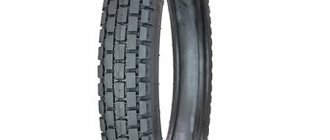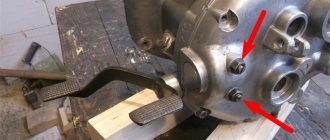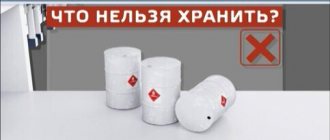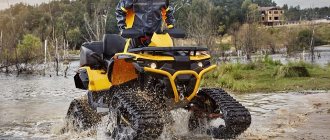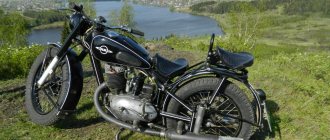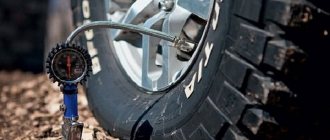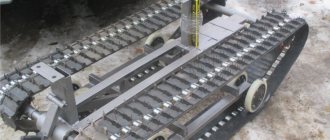Which motorcycles are best suited for conversion into an all-terrain vehicle (snowmobile)? During the snowy winter period, many motorcycle owners come up with the idea of creating an all-terrain vehicle out of their motorcycle. To do this, you need to install the caterpillar on the wheels. In principle, this can be done with any “iron horse,” but most users agree that the best domestic unit for such a change is the Dnepr, Izh, or Ural motorcycle.
Even during the Second World War, a German motorcycle on tracks was known, which was designed by the inventor Heinrich Ernst Kniepkamp. At first it was used only by German paratroopers, but later became more common as a traction force. It continued to exist after the war; the remaining models were actively used in agriculture.
Two main types of all-terrain vehicles
In our huge country there are a large number of craftsmen who can create a winter form of transport from a motorcycle or walk-behind tractor. All of them have at least basic knowledge of auto mechanics, a certain number of spare parts for motorcycles, and a lot of imagination. Each such vehicle is unique, but they have something in common. Some authors place their equipment on a caterpillar track, others install a structure with skis in place of the wheels. Leading skis can be either front or rear skis.
Before you conjure up your favorite motorcycle, you need to stock up on some knowledge or the help of knowledgeable designers. After all, your equipment may break. But often in our conditions it is impossible to simply drive in the snow. This kind of riding is similar to driving on sand or mud, but in deep snow the motorcycle can even stall, and it won’t be able to travel on every rut. Therefore, we choose the lesser of two evils and still decide to make changes.
Retro motorcycles
In 1940, the Ministry of Armaments of the Third Reich issued a task according to which it was necessary to create a light and maneuverable tractor capable of working in cramped mountain conditions. Load capacity is limited to 500 kg. The second serious limitation is the possibility of transportation by plane. The development of the tractor is undertaken by the company Neckarsulmer Fahrzeugwerke, AG, better known as NSU. In just a few months, under the leadership of the prominent German designer Ernst Kniepkamp, the experimental workshop of the plant produces a machine of a very unusual appearance for state testing.
Kettenkraftrad moves along the trench. In a short time, the engineering and design department designed and manufactured 11 tractor samples. The solution to the problem was helped by the fact that Ernst Kniepkamp had already tried to offer the Wehrmacht a similar transport several years earlier, but then the attempts were unsuccessful. In the same year, 1940, the tractor successfully passed tests and was adopted by the Wehrmacht. The main problem that the tractor was designed to solve was towing and transporting goods in difficult mountain conditions. The installation of a tracked propulsion system solved several problems at once: reliable traction with the road, which made it possible to implement a powerful engine from a car, a small width, which provided the ability to maneuver in narrow areas and off roads, as well as the possibility of a “tank” turn on the spot.
Staged photograph for printing. 1941
The heart of the NSU Kettenkrad HK 101 SdKfz2 is an automotive, in-line 4-cylinder Opel Olympia petrol engine with 36 hp. and volume 1.3 l. The transmission included a dry single-plate clutch, 3-speed gearbox, range and double differential. The chassis included a motorcycle-type front steering wheel, a caterpillar propulsion unit consisting of five double rubber-coated rollers and a chain belt, 170 mm wide, with rubber cushions. There was a driver's seat in the front part of the car's hull, and two more seats were equipped in the rear part of the hull. The dry weight of the motorcycle was 1235 kg. It could carry a load of 325 kg and tow trailers weighing up to 450 kg. Fuel tanks with a total capacity of 42 liters, located on the sides of the driver's seat, provided a cruising range of 260 km on the highway and 175 km over rough terrain.
Somewhere on the eastern front. Autumn 1943
The staggered arrangement of the rollers made it possible to distribute the load between the axles of the tractor - this increased the service life of the parts, reduced the weight of the structure and reduced the specific gravity on the ground. The smoothness of the car's movement was also improved. The inventor of the pendant is Ernst Kniepkamp. It was this type of suspension (named after the author) that would later be used on the Tiger and Panther tanks.
Driver's workplace. Our days
Contrary to popular belief, the steering wheel took on only part of the load when turning - the steering wheel not only turned the wheel, but also acted on the track differentials, “slowing down” the required track. Thus, an experienced driver could turn a three-meter car around on a patch with a diameter of 4 meters.
Two-way traffic along a forest clearing.
In parts of the Wehrmacht, the car was given its due. The combination of ease of maintenance, small size and ease of control won recognition from all soldiers in whose hands this tractor was. The small width made it possible to travel where it was impossible to use any other means of transportation. The soldiers jokingly called him the “Crawler Horse.” In the photo above, there is two-way traffic along the forest clearing, in which Kettenkrad feels great among the carts, even despite the muddy roads. In the title photo of the article, a tractor is driving along the bottom of an anti-tank ditch. The properties of the car allowed it to move even in the complete absence of roads.
Mountain roads. 1942
But the tractor has not lost its original purpose. It is worth saying that the mountain ranger divisions of the Wehrmacht, before the appearance of the described tractor, moved all the equipment either on horseback or with their own hands. For example, a “lightweight” howitzer weighed just under 800 kg. It is not surprising that the “crawler” motorcycle was in such demand.
Although the Kettenkraftrad was developed for the Luftwaffe parachute troops, it was never parachuted. Such technologies are only a thing of the future. As a rule, it was delivered to an airfield captured by paratroopers.
As a tractor, the Kettenkrad could pull a light weapon or a special standard trailer even in severe muddy conditions. In most archival photographs, the tractor is busy towing and carrying passengers - a real “front-line workhorse.”
Clearly overloaded Kettenkrad. If the plane is empty, then the abnormal load is “only” 5 people (instead of the standard two) and 5.2 tons. If the plane is loaded, up to 10 tons are towed on the hitch. Probably the airfield personnel intentionally made the tractor heavier.
However, the tractor also had disadvantages. The main one is the difficulty of maintaining the suspension. Despite the high reliability of the units, their repair was not uncommon and in this case all the suspension rollers had to be removed. However, on a modest tractor these were still “flowers”. The mechanics will really cry in a few years, when the Tiger tank with 4 rows of rollers enters service.
The next drawback is the Orthodox impurities of our Motherland. Or rather, their autumn and winter condition. Often, in the morning it was necessary to light a fire under the tractor to set in motion the rollers that had frozen overnight. Later modifications of the tractor were equipped with a blowtorch, which “defrosted” not only the engine, but also warmed up the crankcase. However, despite this drawback, the car was very highly valued, primarily on the Soviet-German front. The vehicle's cross-country ability especially played a role in the fall of 1941, when the Wehrmacht had to advance along roads that had been completely destroyed by the retreating Soviet army. It was the events of the first autumn of the Great Patriotic War that forced the German leadership to reconsider plans for the production of a non-priority “mountain” tractor and, instead of several hundred per year, start producing thousands.
The passengers are having fun, but the driver is clearly nervous - for good reason.
A separate drawback is the high center of gravity - often the tractor would tip over. This was facilitated by both a narrow wheelbase and an impressive maximum speed - up to 50 km/h on good surfaces. At the same time, the driver rarely had time to jump out of the saddle. By the way, it is worth noting the considerable noise that the tracks made when driving on smooth asphalt - they tried to transport it along the roads by truck.
Good view of the tractor from behind. You can see spacious passenger seats, a standard Sd.Ah 1 trailer. You can pay attention to the mudguards - Kettenkrad easily reached speeds of 30-40 km/h. August-September 1943
In the first modifications, when driving over rough terrain, the steering wheel suffered greatly - later the spoked wheel was replaced with a solid cast one. When constantly moving in muddy roads, the front wheel was sometimes simply removed so as not to collect dirt in front of it.
In the photo, mountain rangers are successfully moving up a snowy slope. The wheel has been removed.
Judging by the situation, it is the territory of the USSR. Time and place unknown.
An edelweiss flower is visible on the front wing. 1st Mountain Rifle Division of the Wehrmacht.
A total of 8,871 tractors of various modifications were produced during the war years. But even after the war, production continued - at least 500 units were assembled from kits, which entered service in the ladder industry or went to agriculture.
In addition to the production of original tractors, the French company Babiole after the war produced a small tractor based on the described tractor. Engineers abandoned the steering wheel and rotated the driver's seat 180 degrees. By the way, the Germans initially planned to launch additional production of motorized tractors on the basis of enterprises in occupied France, but due to the Allied landings, these plans were not destined to come true. As history has shown, the French made good use of the documentation and Kettenkrad samples handed over to them.
Vignoble Tracteur - “Grape tractor” made in France.
On the territory of the USSR, captured tractors were used with might and main by the local population. The author of the article knows of a case where in the mid-90s an old Kettenkraftrad was bought from his grandfather in a remote village directly from under a homemade plow. My grandfather brought it himself in 1945 and since the end of the war he has been plowing his garden on it.
In the Kubinka Armored Museum you can see a preserved copy.
Materials used: 1) Wikipedia 2) Great article from reenactors. 3) Article from the domestic magazine Offroad Drive. 4) Several photos from the search engine that belong to their rightful owners. 5) Pen & Sword “Images of War - Motorcycles at War”
Gentlemen, read the links - they contain a lot that is not included in the article. Indeed an interesting read! (And with pictures too!!!)
Features of manufacturing tracks for motorcycles
Of course, you can always buy factory-made snowmobile skis or track wheels. Then the need to invent something will disappear. But we are not looking for easy ways, and not everyone has the opportunity to purchase new spare parts. Sometimes it's not the price or the fact that the parts are hard to find. For some people, it’s a hobby to create their own “transformer” and ride it around their town. That's why we decided to put together some tricks that different craftsmen use to create their snowmobiles to make your creative process easier.
Expert commentary
| Evgeniy Belash, military-historical publicist, author of the books “Tanks of the Interwar Period” and “Myths of the First World War,” as well as articles on historical topics for the Warspot and Warhead portals. |
— By the end of the war, Soviet motorcyclists fought not alone, but in a solid combat company - light tanks, self-propelled guns, armored personnel carriers and all-terrain vehicles.
The usual composition of the advance detachment was: a company of motorcyclists, a platoon of mortars, a company of self-propelled guns (including Lend-Lease guns), a battery of 76-mm guns and a platoon of sappers. Such a detachment could solve a variety of combat missions. Motorcycle units were used both for reconnaissance and for capturing strongholds or road junctions, crossings and bridges. During the offensive, they served as the vanguard of even formidable tank armies - pinning down the enemy until the main forces arrived, knocking the enemy off their occupied lines and cutting off escape routes.
When the enemy front was broken through, motorcyclists “on the shoulders” of the retreating enemy burst into the cities and caused panic. Having dismounted, the motorcyclists threw grenades at the armored vehicles. And in defense, they were the first to meet the enemy. There are cases when motorcyclists, with the support of tanks and self-propelled guns, fought even with heavy German “Panthers”. Motorcycles at war: microscooters, mortars and caterpillars
Best materials
Most craftsmen use a material such as aluminum to make spare parts. It lends itself well to deformation, is easy to drill, grind, and is not heavy, which will help give your vehicle additional maneuverability.
Caterpillars are made from spiked rubber, tires, and chains. For their manufacture, sheet steel is most often used. Now let's figure out how to build a snowmobile or all-terrain vehicle from a motorcycle.
First developments
A crawler motorcycle is a rather complex structure. Its development was carried out by professional and private designers at the beginning of the last century. The prototype of such a motorcycle was the tracked bicycle, which was developed in 1900 by Henry Steese. He even received a patent for his invention.
Further, in Great Britain in 1927, one of the first motorcycles was created, which had two rear wheels on tracks. It was called RASC Triumph. This vehicle was manufactured by order of the royal army. The model was converted from a similar development with a 2x1 propulsion unit. RASC Triumph received a 3x2 propulsion unit. This motorcycle was made in one copy. When tested, its ride quality was excellent. However, the development was not further developed. Standard motorcycles, which were owned by the royal army at that time, received improved mobility characteristics.
The RASC Triumph is now housed in a museum dedicated to army transport. It is almost impossible to restore the presented vehicle. Museum officials claim that the motorcycle's authentic 11-inch rear tires have been lost.
Physical Features
When designing such a vehicle, you need to remember several important laws of physics, without knowledge of which your work will be reduced to zero. For good cross-country ability on a snowy surface, you need to make the contact area with the coating as large as possible. This will help the snowmobile not to fall through. In order to reduce the load on the snow cover, you need to make the weight of your vehicle as small as possible. In order for your snowmobile to be stable, another law of physics should be applied - you need to make at least three points of support. That is, a snowmobile with three skis will be more stable when moving than with two. The design may consist not only of skis, but, for example, of one track and two skis or, conversely, of a ski and a pair of tracks. There can be four support points, then you will get something resembling an ATV.
Most often, such units as “Dnepr”, “Izh” are used for such conversion; you can also find a “Ural” motorcycle on tracks. The steering part is left original; all the necessary systems are connected to it - clutch, gas lever. Steel pipes or angles are used for the frame. To make the ski, sheet steel and again angles are used.
Features of design and operation
It’s worth starting the analysis with the caterpillar, it has interesting features:
- Due to the design of the trolley, the caterpillar does not lose traction with the snow - the elastic design promotes constant contact with the surface;
- There is a slight curvature visible in the track frame. This design feature allows you to change the contact area depending on the surface.
- The length of the caterpillar is smaller than the wheel, but the width is about 25 centimeters, which provides increased stability.
The ski that replaces the front wheel only at first glance seems like an ordinary piece of plastic. In fact, it is a functional and durable suspension element .
The ski allows you to deflect the front part by 6 °, but at the same time contact with the surface is not broken.
Another feature is the presence of lateral incisors that bite into the snow . In addition to turns, the tip of the ski can be lowered and raised.
Thanks to these actions, you can cope with any snow conditions.
For example, when overcoming soft snowdrifts, you should lift the ski , then it will not bury itself, and the motorcycle will glide without braking.
In the case of hard surfaces, you need to do the opposite - a lowered toe will provide excellent glide.
Track manufacturing technology
Making a caterpillar for a motorcycle with your own hands is not difficult for those in the know. Let's look at the most common method.
We make the caterpillar for the motorcycle from a conveyor belt, which we divide into 4 parts. The resulting strips are 5.5 cm wide. We assemble them into a single structure using U-shaped profiles. The track supports need to be balanced. Balancers are made of steel sheets. We cut out the halves of the disks using stamps. We take bronze hubs or grind them ourselves.
Then we connect the half-disks with six bolts. The blanks for balancing are ready. It is necessary to make shafts for the support drums at the front and rear. They are made from steel rod. They make holes for the bearings and insert them there. The support drums are made of aluminum or duralumin parts. Then the structure is connected with bolts. When installing, rubber sprockets are inserted between the support drums.
And now the caterpillar on the motorcycle is already rotating from the chain. A special unit, which is attached to the ear of the bushing at the front, helps to fix this entire structure on the back of the all-terrain vehicle. Two such ears are needed; they should be welded onto the longitudinal pipes and the previously made balancers should be attached. Here is the main part of the work that allows you to make a snowmobile on tracks from a motorcycle.
Photo gallery
Off-road motorcycles – motocross and sport-enduro – are vehicles for year-round use. They, unlike other two-wheeled brothers, do not hibernate. In this collection you will find photos of motorcycles of various models with tracks installed on them.
Second life for old tires
There is another well-known method. Let's look at how to make a homemade motorcycle track using old tires. For such work, it is best to choose tires from large trucks. It is better that the tread pattern is kept in satisfactory condition. To work, we will need a very sharp shoe knife and some cutting skills, no matter how strange it may sound. In the manufacture of such a caterpillar, the method of cutting out the sides from tires is used. To ease the effort when cutting thick tires, you need to periodically dip the knife in a soapy solution. You can also use an electric jigsaw with fine teeth.
So, for old tires we remove the beads, select parts with a well-preserved tread pattern, or we will have to cut it ourselves to improve grip on the road surface. The undoubted advantage of such a tire chain is that it consists of a closed solid material, which means it is more resistant to breaks. The disadvantage of this design is the limited tire size.
All in your hands!
We see that you can convert any motorcycle or walk-behind tractor, put it on tracks, skis, or combine it. Fantasy is not limited by anything except its own capabilities. First, look around your garage - maybe you already have a caterpillar for a motorcycle in stock. If so, you can begin assembly. Even if you are using a track for a motocross motorcycle, do not forget about safety, which should come first. You need to think not only about yourself, but also about those around you who you may harm. Take a test drive in a deserted area. Was the test drive a success? Now we're off to the track!
There are a huge number of options, all of them unique in their own way. They can safely be classified as handmade, because almost every detail is made individually. The choice of materials and manufacturing methods is also huge. In addition to a standard set of plumbing tools, you will definitely need a welding machine, possibly a pipe bender, an angle grinder, etc. But one thing is clear: making a track for a motorcycle and turning it into a snowmobile yourself is much more interesting, and most importantly, cheaper than simply purchasing ready-made components.
